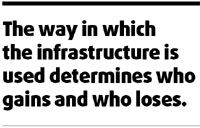When infrastructure can lead to impoverishment
Updated: 2008-02-05 07:30
India's deputy chairman of the Planning Commission, Montek Singh Ahluwalia, has said that the 11th Plan has placed special emphasis on infrastructure, both urban and rural.
"Many people think of infrastructure as relevant only for economic growth, (but) it is also relevant for inclusiveness," he said in an interview.
It is heartening that he is concerned about inclusiveness. But we have been hearing the same for the last 200 years.

A similar trend is noticeable since independence. In recent years our villages have been given access to mobile phones, cable TV, diesel pumps and bus services. Yet the exodus to the cities continues unabated. Indeed, the development of infrastructure runs parallel to impoverishment.
The problem lies in the nature or direction of infrastructure. A road to a village can be used by doctors making house calls. Or they can be used to transport sugarcane to the city.
Electricity supply lines can be used to connect villages to power generated at nuclear power stations. Or they can be used to supply power generated at rural windmills to the city. The way in which the infrastructure is used determines who gains and who loses.
Sweet water from the Indira Gandhi canal has reached my ancestral village, Malsisar in Rajasthan's Jhunjhunu district, through pipelines. An all-weather road has been constructed. It is used to transport the local produce to the markets. Guar, a plant grown as a vegetable and for gum used in the food and paper industries, is cultivated in the area and sent to the processing factories.
Water pipelines and roads have had a reverse impact though both are infrastructure. Pipelines deliver water to villages, while roads extract resources from them.
Dadua village in Tehri district of Uttarakhand is facing a shortage of drinking water. The village is situated 3 km above the banks of the Alaknanda river. The locals have demanded that drinking water be pumped from the river, as is the case in nearby Bagwan town. The proposal seems to be gathering dust in government files.
On the other hand, the government is going ahead with a dam on the same river. Section 17 of the Land Acquisition Act, which was promulgated for such eventualities as war, is being invoked to acquire land forcibly from unwilling farmers.
The dam is a curse for the local people, but will provide power to run the air-conditioners of officers sitting at Dehra Dun. The pumping station to supply water to Dadua and the dam to supply power to Dehra Dun are both part of the infrastructure.
For the past decade, the Internet has been available in Gurgaon and Mysore. The BPO industry is booming. Indian companies are demanding and getting substantial prices for their services. This has led to the flow of global wealth to India.
Infrastructure can be compared to a child's sea-saw. Two children can play equally happily. But if one is too heavy then he sits pretty and lifts the other higher. The latter urges the "big bully" to bring him down. The sea-saw serves the bully and is a curse for the little boy.
Infrastructure offers a similar analogy. It connects the village and the city, India and England and Gurgaon and New York. But who gains and who loses depends upon who is stronger in the bargaining process.
Thus the all-weather road at Malsisar, the hydropower dam on the Alaknanda and the rail lines laid by the British led to impoverishment. On the other hand, the water supply pipeline at Malsisar and Dadua and Internet lines at Gurgaon have led to development.
The building of infrastructure should be preceded by economic policies that strengthen the bargaining power of the rural against the urban sector.
The Statesman/Asia News Network
(China Daily 02/05/2008 page9)
|
|
|
|
|
|